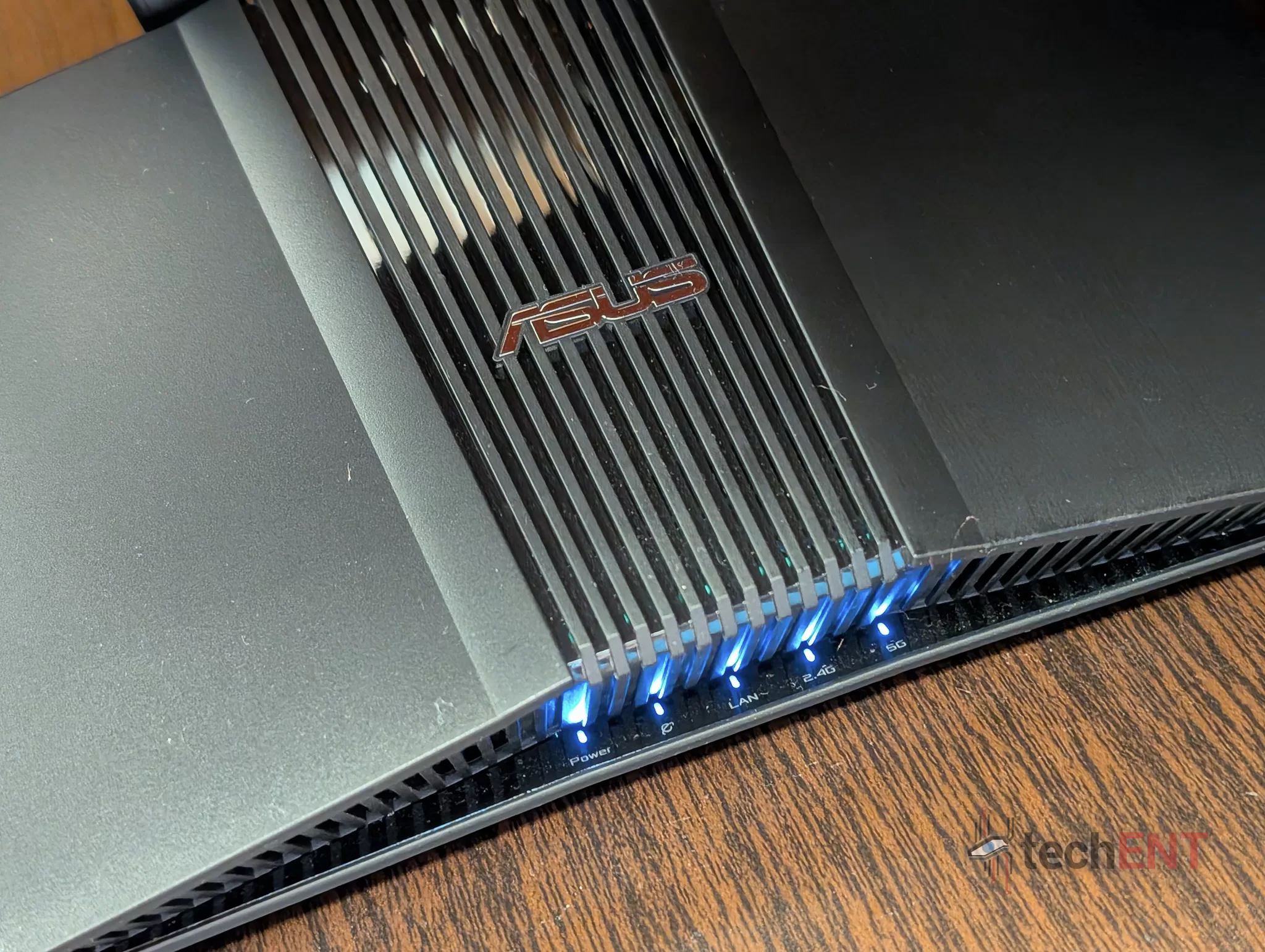
As the world becomes ever more connected, the need for faster, more instantaneous connectivity continues to grow. This need for connectivity is driving a revolution in the WiFi connectivity space with the development of new standards that support higher speeds and data throughput. The latest standard – WiFi 7 – takes the speed and throughput of WiFi 6e and supercharges it. However, to benefit from it, we need new routers and devices that support the new standard. That’s where the new ASUS RT-BE58U WiFi 7 router comes in.
The new router provides a relatively affordable entry point for the regular Joe to adopt the new WiFi standard and benefit from the higher throughputs and features of WiFi 7. However, does the router justify its RM628 price point? We’re breaking down the router and its features to see whether ASUS continues to hit the mark with the new RT-BE58U.
Design & Build Quality
The ASUS RT-BE58U marks a departure from the more aggressive aesthetics we’ve sometimes seen in ASUS routers, embracing a new design language that leans towards futuristic minimalism. It manages to strike a balance, offering a look that’s both modern and understated, allowing it to integrate smoothly into a variety of environments without drawing undue attention. The design cues clearly echo the ZenWiFi series, with its combination of parallel lines and negative space creating a visually appealing finish.

However, unlike the typically low-profile ZenWiFi mesh nodes, the RT-BE58U sports four rather prominent antennae. These aren’t just for show; they are crucial for harnessing the capabilities of WiFi 7, a topic we’ll delve into in more detail later. Despite their size, the sleek design of the router body ensures that the antennae don’t overwhelm the overall aesthetic.
Beyond its looks, the RT-BE58U feels reassuringly solid in hand. While the construction is predominantly plastic, there’s a definite sense of quality to the materials used, avoiding that flimsy feel. It seems capable of withstanding the rigours of everyday use, though we’d still recommend against any impromptu drop tests. All the essential ports and buttons – Ethernet, power, reset, and WPS – are conveniently located at the rear, maintaining a clean and accessible profile.
Interestingly, ASUS has also incorporated a degree of environmental consciousness into the design and manufacturing process. The router utilises up to 30% post-consumer recycled (PCR) plastic in its construction, a subtle nod towards reducing its environmental footprint. Furthermore, the packaging adopts FSC (Forest Stewardship Council) certified materials, indicating a commitment to responsible sourcing of paper and wood products. This blend of modern design with a consideration for sustainability is a noteworthy aspect of the RT-BE58U’s overall presentation.
Features
The ASUS RT-BE58U steps onto the scene as a forward-looking router, packing the fresh tech of WiFi 7. Promising faster speeds and smarter connections, it’s aiming to be the backbone of your digital life. Beyond the next-gen wireless, you’ll find features designed to expand your network, keep it secure, and even consider the planet. Does all this translate to a smoother, more reliable online experience? Let’s dive into the key features and see what this router brings to the table.
Connectivity & WiFi 7
The ASUS RT-BE58U incorporates WiFi 7 technology, offering a theoretical maximum combined speed of 3600 Mbps across its dual bands. The 2.4 GHz band is capable of reaching up to 688 Mbps, suitable for less demanding tasks and a wide range of connected devices. The 5 GHz band offers a significantly higher potential at 2882 Mbps, which could benefit applications requiring greater bandwidth, such as high-resolution streaming and online gaming.
A key feature of WiFi 7 implemented in this router is Multi-Link Operation (MLO). This technology allows compatible devices to establish simultaneous connections over both the 2.4 GHz and 5 GHz bands. The potential benefit of MLO lies in its ability to improve connection stability and reduce latency by dynamically utilising both frequencies. This could lead to a more consistent wireless experience for devices that support this capability.
The inclusion of 4K-QAM (4096-QAM) represents an increase in data encoding efficiency compared to the 1024-QAM used in previous WiFi standards. This higher modulation order allows for the transmission of more data within the same radio frequencies, potentially resulting in faster data transfer rates for compatible clients. The router also supports 160 MHz channel bandwidth on the 5 GHz band. Wider channels can facilitate higher data throughput, particularly in environments with less radio frequency interference. The presence of a 2.5G Ethernet port for both WAN and LAN connectivity offers the potential for high-speed wired connections, accommodating internet plans exceeding 1 Gbps and high-bandwidth local network devices.
Network Expansion & Flexibility
The ASUS RT-BE58U features AiMesh support, enabling the creation of a mesh network by pairing it with other compatible ASUS routers. This allows for extended wireless coverage throughout a larger area, potentially mitigating signal dead spots. The system is managed through a centralised interface.
The “Smart Home Master Network” functionality allows for the creation of up to three distinct SSIDs. This enables the segregation of different types of network traffic, such as primary devices, IoT devices, and guest access. This separation can contribute to better network organisation and potentially enhance security by isolating different device categories.
The inclusion of 4G LTE/5G mobile tethering via a compatible USB modem provides a backup internet connectivity option. This feature allows the router to utilise a cellular network in the event of a primary wired connection failure, offering a degree of redundancy for maintaining internet access.
Security & Parental Controls
The ASUS RT-BE58U incorporates AiProtection Pro, a security suite powered by Trend Micro. This includes features such as blocking access to known malicious websites and a two-way Intrusion Prevention System (IPS) designed to monitor network traffic for potential threats. The software also includes the ability to identify and block infected devices on the network.
The router offers parental control features, including an activity dashboard for monitoring internet usage. It also provides preset age-based content filters and the ability to schedule internet access times for connected devices. These tools allow for the management of online access for children on the network.
The router supports VPN client and server functionality, including the WireGuard protocol. The VPN client allows devices connected to the router to establish secure connections to external VPN servers. The VPN server functionality enables secure remote access to the home network.
The ASUS RT-BE58U presents a standard router form factor with external antennas designed to facilitate wireless signal transmission. The physical build quality will require further assessment through hands-on examination. The rear panel includes standard Ethernet ports, including the aforementioned 2.5G port, for wired connectivity.
ASUS has incorporated a degree of sustainability in the production of this router by using up to 30% post-consumer recycled (PCR) plastic in its construction. The packaging utilises materials certified by the Forest Stewardship Council (FSC), indicating responsible sourcing.
Performance
The ASUS RT-BE58U, equipped with WiFi 7, demonstrated measurable performance differences when compared to the WiFi 6-based ASUS RT-AX3000 in our test environment. In close proximity (within 3 meters), the RT-BE58U achieved average download speeds of approximately 950 Mbps on the 5 GHz band using a WiFi 7-enabled client. This represents an increase from the average of 650 Mbps recorded by the RT-AX3000 under identical conditions. At a distance of roughly 9 meters, separated by a standard drywall, the RT-BE58U maintained an average throughput of 780 Mbps, compared to the RT-AX3000’s 500 Mbps in the same test. The 2.4 GHz band exhibited an average speed of 280 Mbps, a modest improvement over the RT-AX3000’s 220 Mbps.
Latency performance also showed notable improvements, particularly under moderate network load. In online gaming scenarios, such as Overwatch 2, the average ping time on the RT-BE58U was observed to be in the range of 10-15 ms, compared to the RT-AX3000’s average of 18-22 ms. Even with six additional devices actively engaged in video streaming and file downloads, the ping on the RT-BE58U remained relatively stable, with occasional peaks around 25 ms, indicating effective management of concurrent connections.
In terms of stability, the RT-BE58U experienced a low frequency of disconnections during our testing period, with fewer than three instances observed over a week of continuous use. Packet loss remained minimal, measuring below 0.1%.
An unexpected behaviour was the inability of specific smart devices, namely a Haier TV and a Philips Air Purifier, to connect to non-IoT designated SSIDs. These devices only successfully connected when associated with an IoT-specific network created by the router. This suggests potential compatibility considerations for users with certain types of smart home devices.
The wireless range of the RT-BE58U demonstrated a notable extension compared to the RT-AX3000. In a scenario involving signal transmission through a concrete wall, the RT-BE58U maintained a usable signal up to approximately 21-23 meters, whereas the RT-AX3000’s effective range in the same conditions was around 15-17 meters.
When subjected to simultaneous high-bandwidth activities, such as four concurrent 4K video streams and online gaming on two separate devices via WiFi, the RT-BE58U maintained stable performance. Utilising the Quality of Service (QoS) settings to prioritise gaming traffic resulted in a consistent ping time below 18 ms on the designated gaming device, even with the concurrent streaming load, indicating the QoS functionality’s effectiveness in managing network resources.
An Affordable Option to Step into the WiFi 7 Era
The ASUS RT-BE58U presents a compelling entry into the nascent world of WiFi 7 routers. Our testing reveals tangible improvements in wireless throughput and a notable enhancement in latency management, particularly in environments with a multitude of connected devices. The extended wireless range is also a significant advantage, offering broader coverage compared to previous-generation WiFi 6 models. For users looking to future-proof their home networks and experience the potential of WiFi 7, the RT-BE58U offers a solid foundation.
However, it’s not without its quirks. The observed incompatibility with certain non-IoT devices on standard SSIDs is an unusual limitation that potential buyers should be aware of, especially if they have a diverse range of smart home technology.
Priced at RM628, the ASUS RT-BE58U positions itself as a mid-range option in the evolving WiFi 7 landscape. While it delivers on the promise of next-generation performance in key areas, the noted device compatibility issue warrants consideration. Ultimately, the RT-BE58U offers a glimpse into the speed and efficiency benefits of WiFi 7, making it a worthwhile contender for those ready to embrace the latest wireless standard, provided





